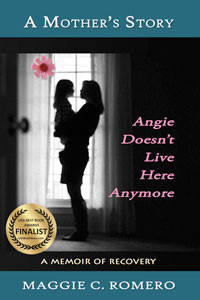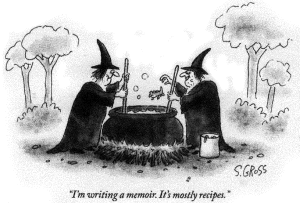It was a pleasure to listen to John Evans on Friday’s NAMW Teleseminar. My recovery memoir exemplified a number of the kinds of writing he talked about in the interview with Linda Joy Myers: writing for healing and transformation; affirmative writing; legacy writing; and transactional writing.
A Mother’s Story: Angie Doesn’t Live Here Anymore began as an attempt to heal from the pain of my daughter’s drug addiction. But as I dug deeper into those dark places he referred to, I uncovered many more truths about myself that I was ready to expose and come to terms with. This isn’t automatic for many memoir writers; indeed, this is often that terrifying place where the writing process stops and they back away, hoping to revisit another time. Readiness comes at a different time and place for all of us, but I’m glad I was prepared to do the work that led to self-discovery and change. The cathartic process of typing ten hours a day for two years until my hands ached with arthritis proved to be a worthwhile effort. The grief around my daughter and my family of origin ceased to be a crippling force in my life, and I’ve truly been able to move on. Anger and depression left me, forgiveness (of self and others) came easily, and most importantly, acceptance of things as they are—without resistance— became my mantra.
Shedding the negativity that had imprisoned me for so many years leads me to another kind of writing that John Evans talked about: affirmative writing. In a way, my whole memoir, from beginning to end, stands under the light-filled umbrella of my recovery. I injected the positive change in me into every chapter as I looked back on my life—not with anger, sadness, and guilt—but with a fresh perspective. Gratitude, understanding, love and acceptance of what is are so much easier to carry. And they’re the big takeaway from my story. It started out in a very dark place, but as the memoir expanded, thankfully, “the light got in.”
John also talked about legacy writing. How do we want people to think about us, and how do we want to be remembered? This brings me to the last type of writing he discussed: transactional writing. This is “getting down to business,” where we address issues on the page with someone else. But the other people we’re talking to need to be listening!
In my case, my siblings have not read the memoir because they fear the opening of old wounds. This is a reflection of where they are in their own healing process. Also, and John mentioned this in his own experience, siblings often have very different memories growing up in the same home. My brother, sister and I are all five years apart, and this was the case with us. Clearly, we’re not all on the same page, and there’s much more healing to be done in my family. But at the same time, some key people in my life haven’t heard my message. When I asked John about this, he assured me that the business was between my text and me—therein lies the benefit. That may be true. Many strangers have read my story and now they know me intimately and even understand me somewhat. But it’s my family that I wanted to know and understand me differently. Perhaps that’s work destined for another place down the road.
So for me alone writing my memoir was a tremendously healing endeavor, and I have indeed found myself transformed by undertaking such an arduous task. This work, to use John’s words, “has helped me move beyond what I thought I couldn’t get over.” I would wish that same clarity and transcendence for all of us!

